Article Review: Demand and Supply Dynamics in the Oil Market
VerifiedAdded on 2022/09/15
|19
|3243
|11
Report
AI Summary
This report provides an in-depth analysis of the international oil market, focusing on the principles of demand and supply as applied to OPEC and its member countries. The study critically examines an article discussing OPEC's revised outlook for 2020, highlighting the impact of the coronavirus pandemic on oil demand and production. The report outlines the theoretical framework of demand and supply, illustrating how price and quantity are determined by market forces and external factors. It analyzes the factors influencing oil demand, such as the availability of substitutes and consumer preferences, and the role of OPEC in influencing market prices. The analysis includes graphical representations of demand and supply curves, demonstrating the effects of decreasing demand and supply on market equilibrium, price, and quantity. The report explores the challenges faced by OPEC, including the decline in oil production, the shutdown of the Chinese economy, and the evolving conflicts within the organization. The conclusion summarizes the impact of the coronavirus on the oil market, emphasizing the challenges for OPEC and the need for comprehensive strategies to maintain market balance. The report also includes empirical analysis, examining OPEC's influence on global oil production, its impact on the oil market, and its role in determining petroleum policies. The report concludes that the pandemic has significantly impacted the oil market, leading to a decline in oil production, market price, and GDP growth.
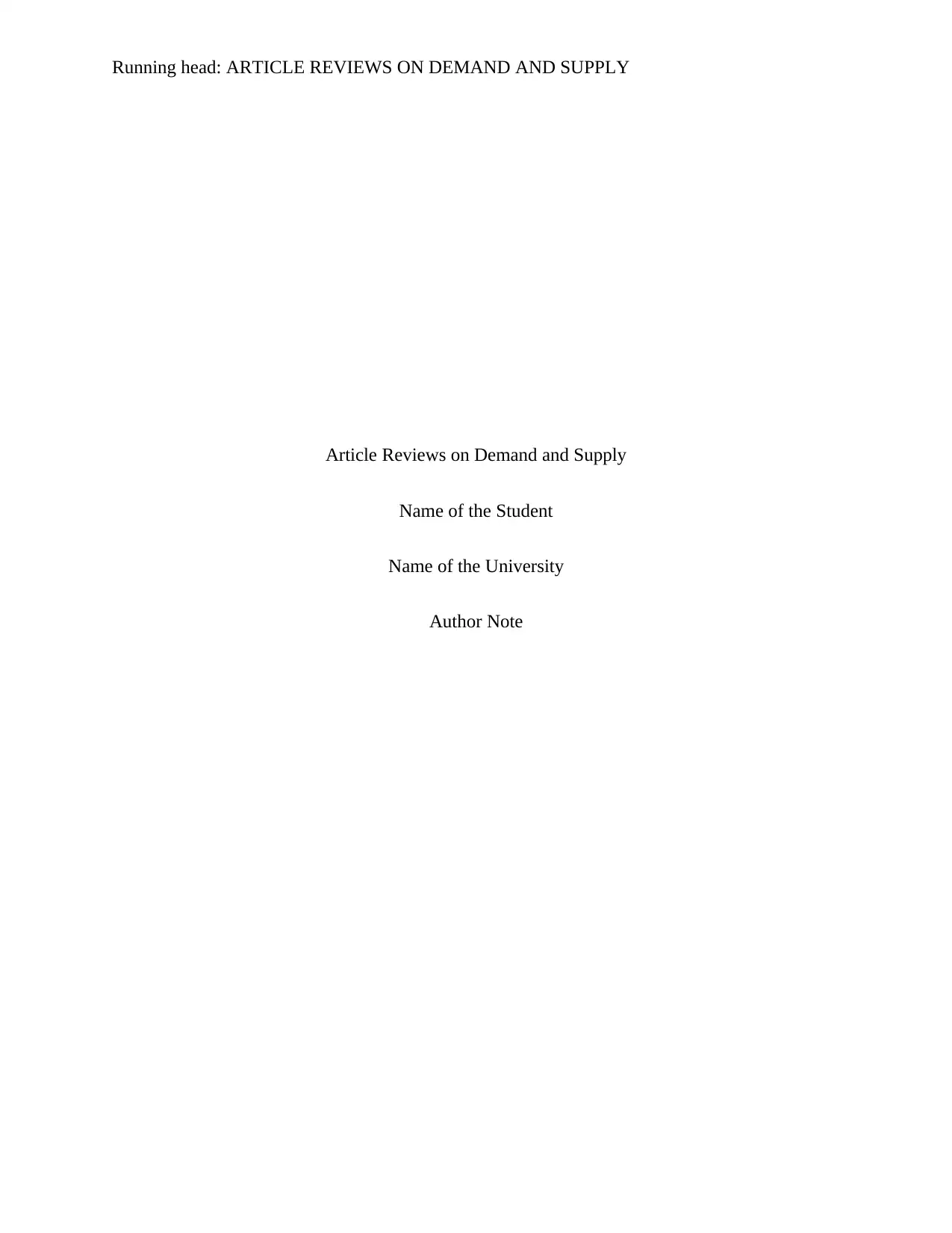
Running head: ARTICLE REVIEWS ON DEMAND AND SUPPLY
Article Reviews on Demand and Supply
Name of the Student
Name of the University
Author Note
Article Reviews on Demand and Supply
Name of the Student
Name of the University
Author Note
Paraphrase This Document
Need a fresh take? Get an instant paraphrase of this document with our AI Paraphraser
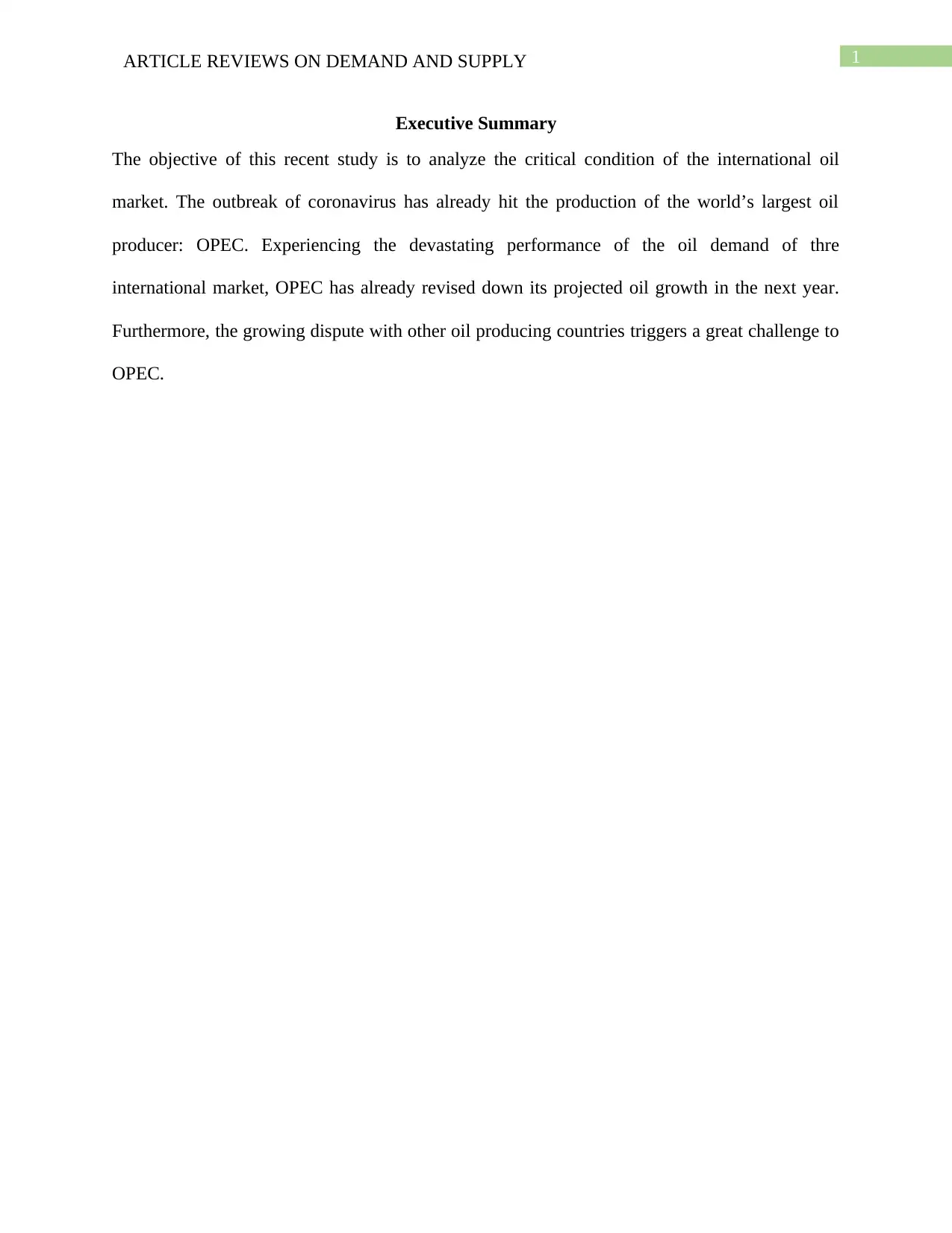
1ARTICLE REVIEWS ON DEMAND AND SUPPLY
Executive Summary
The objective of this recent study is to analyze the critical condition of the international oil
market. The outbreak of coronavirus has already hit the production of the world’s largest oil
producer: OPEC. Experiencing the devastating performance of the oil demand of thre
international market, OPEC has already revised down its projected oil growth in the next year.
Furthermore, the growing dispute with other oil producing countries triggers a great challenge to
OPEC.
Executive Summary
The objective of this recent study is to analyze the critical condition of the international oil
market. The outbreak of coronavirus has already hit the production of the world’s largest oil
producer: OPEC. Experiencing the devastating performance of the oil demand of thre
international market, OPEC has already revised down its projected oil growth in the next year.
Furthermore, the growing dispute with other oil producing countries triggers a great challenge to
OPEC.
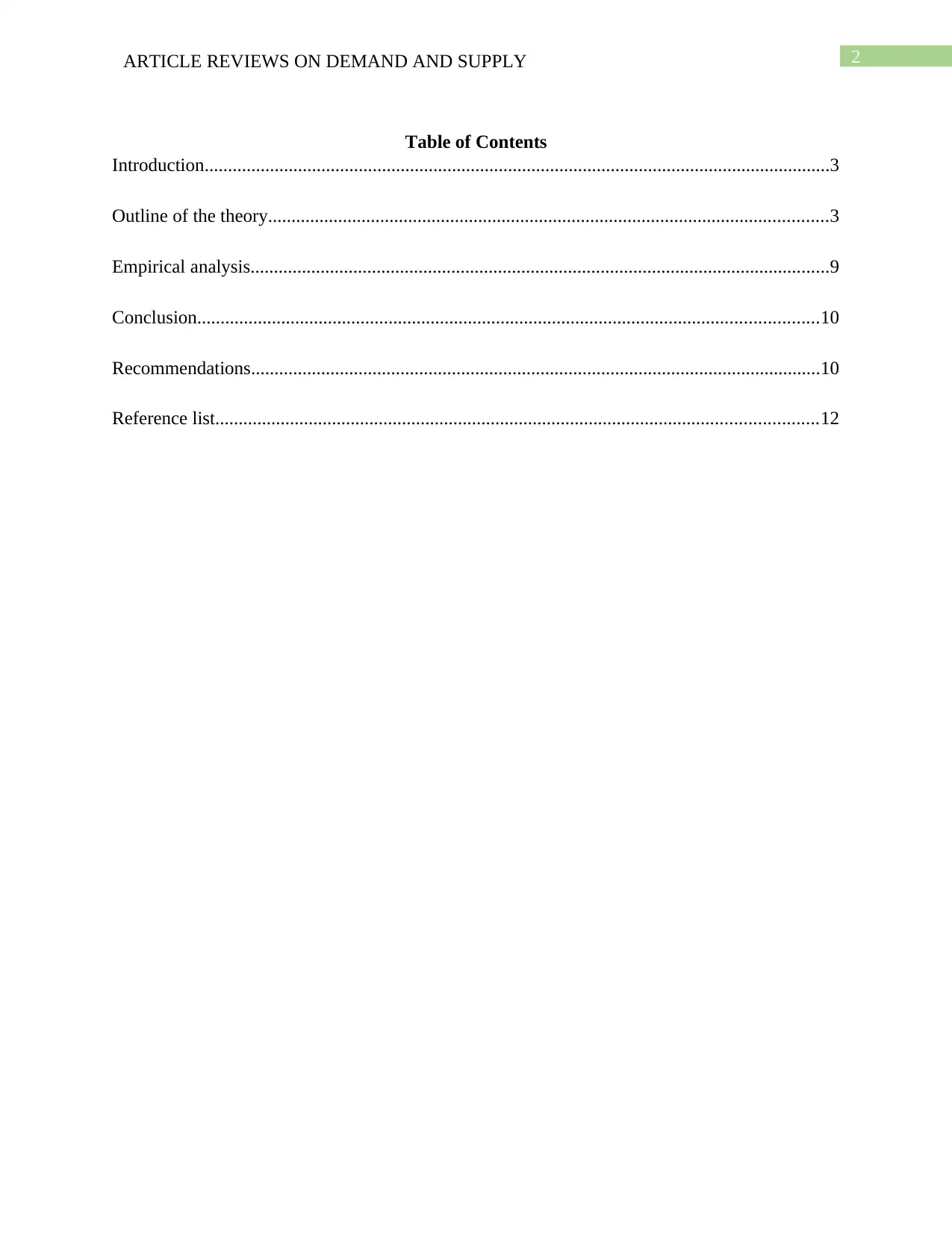
2ARTICLE REVIEWS ON DEMAND AND SUPPLY
Table of Contents
Introduction......................................................................................................................................3
Outline of the theory........................................................................................................................3
Empirical analysis............................................................................................................................9
Conclusion.....................................................................................................................................10
Recommendations..........................................................................................................................10
Reference list.................................................................................................................................12
Table of Contents
Introduction......................................................................................................................................3
Outline of the theory........................................................................................................................3
Empirical analysis............................................................................................................................9
Conclusion.....................................................................................................................................10
Recommendations..........................................................................................................................10
Reference list.................................................................................................................................12
⊘ This is a preview!⊘
Do you want full access?
Subscribe today to unlock all pages.

Trusted by 1+ million students worldwide
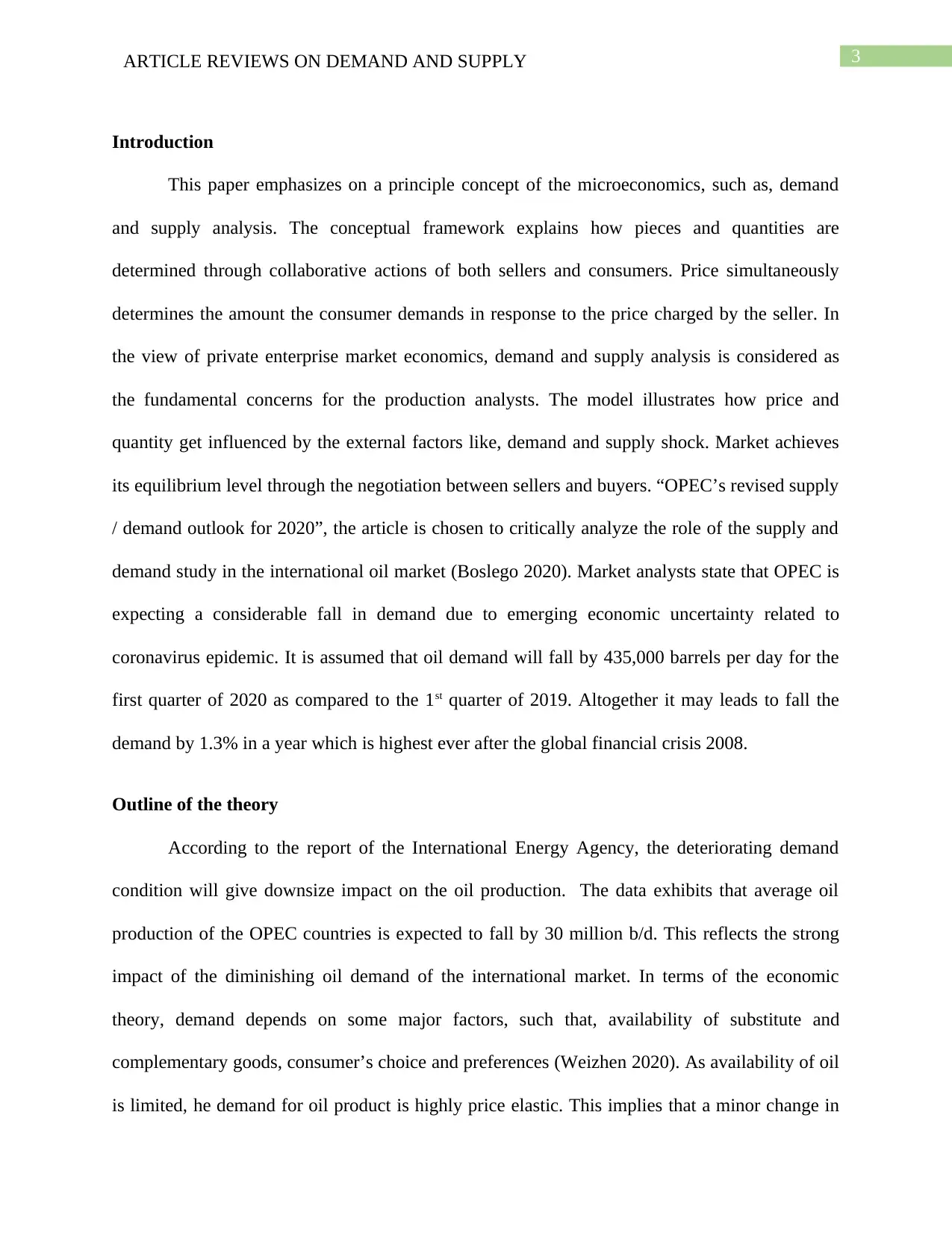
3ARTICLE REVIEWS ON DEMAND AND SUPPLY
Introduction
This paper emphasizes on a principle concept of the microeconomics, such as, demand
and supply analysis. The conceptual framework explains how pieces and quantities are
determined through collaborative actions of both sellers and consumers. Price simultaneously
determines the amount the consumer demands in response to the price charged by the seller. In
the view of private enterprise market economics, demand and supply analysis is considered as
the fundamental concerns for the production analysts. The model illustrates how price and
quantity get influenced by the external factors like, demand and supply shock. Market achieves
its equilibrium level through the negotiation between sellers and buyers. “OPEC’s revised supply
/ demand outlook for 2020”, the article is chosen to critically analyze the role of the supply and
demand study in the international oil market (Boslego 2020). Market analysts state that OPEC is
expecting a considerable fall in demand due to emerging economic uncertainty related to
coronavirus epidemic. It is assumed that oil demand will fall by 435,000 barrels per day for the
first quarter of 2020 as compared to the 1st quarter of 2019. Altogether it may leads to fall the
demand by 1.3% in a year which is highest ever after the global financial crisis 2008.
Outline of the theory
According to the report of the International Energy Agency, the deteriorating demand
condition will give downsize impact on the oil production. The data exhibits that average oil
production of the OPEC countries is expected to fall by 30 million b/d. This reflects the strong
impact of the diminishing oil demand of the international market. In terms of the economic
theory, demand depends on some major factors, such that, availability of substitute and
complementary goods, consumer’s choice and preferences (Weizhen 2020). As availability of oil
is limited, he demand for oil product is highly price elastic. This implies that a minor change in
Introduction
This paper emphasizes on a principle concept of the microeconomics, such as, demand
and supply analysis. The conceptual framework explains how pieces and quantities are
determined through collaborative actions of both sellers and consumers. Price simultaneously
determines the amount the consumer demands in response to the price charged by the seller. In
the view of private enterprise market economics, demand and supply analysis is considered as
the fundamental concerns for the production analysts. The model illustrates how price and
quantity get influenced by the external factors like, demand and supply shock. Market achieves
its equilibrium level through the negotiation between sellers and buyers. “OPEC’s revised supply
/ demand outlook for 2020”, the article is chosen to critically analyze the role of the supply and
demand study in the international oil market (Boslego 2020). Market analysts state that OPEC is
expecting a considerable fall in demand due to emerging economic uncertainty related to
coronavirus epidemic. It is assumed that oil demand will fall by 435,000 barrels per day for the
first quarter of 2020 as compared to the 1st quarter of 2019. Altogether it may leads to fall the
demand by 1.3% in a year which is highest ever after the global financial crisis 2008.
Outline of the theory
According to the report of the International Energy Agency, the deteriorating demand
condition will give downsize impact on the oil production. The data exhibits that average oil
production of the OPEC countries is expected to fall by 30 million b/d. This reflects the strong
impact of the diminishing oil demand of the international market. In terms of the economic
theory, demand depends on some major factors, such that, availability of substitute and
complementary goods, consumer’s choice and preferences (Weizhen 2020). As availability of oil
is limited, he demand for oil product is highly price elastic. This implies that a minor change in
Paraphrase This Document
Need a fresh take? Get an instant paraphrase of this document with our AI Paraphraser
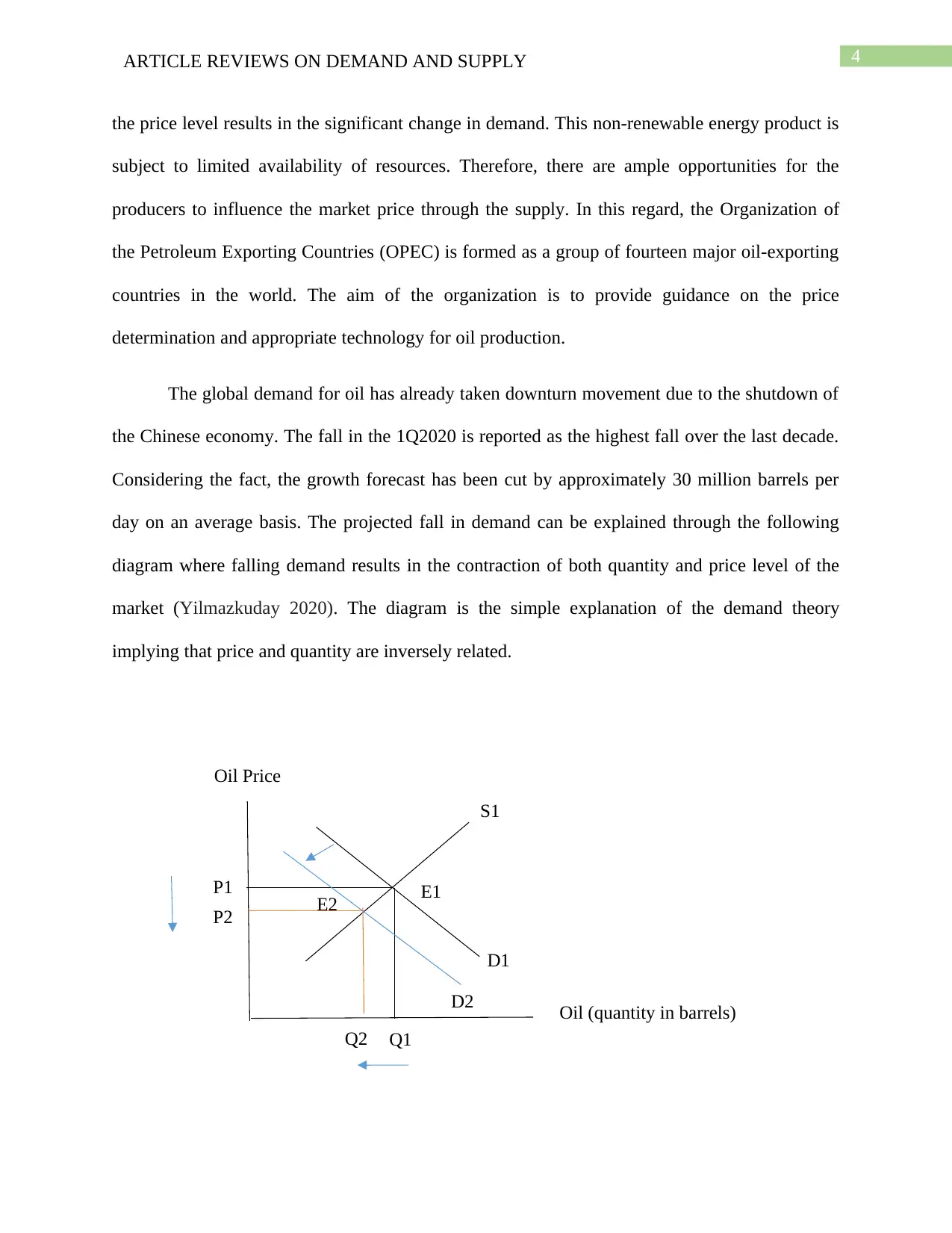
4ARTICLE REVIEWS ON DEMAND AND SUPPLY
S1
D2 Oil (quantity in barrels)
Oil Price
Q2 Q1
P2
P1 E2 E1
D1
the price level results in the significant change in demand. This non-renewable energy product is
subject to limited availability of resources. Therefore, there are ample opportunities for the
producers to influence the market price through the supply. In this regard, the Organization of
the Petroleum Exporting Countries (OPEC) is formed as a group of fourteen major oil-exporting
countries in the world. The aim of the organization is to provide guidance on the price
determination and appropriate technology for oil production.
The global demand for oil has already taken downturn movement due to the shutdown of
the Chinese economy. The fall in the 1Q2020 is reported as the highest fall over the last decade.
Considering the fact, the growth forecast has been cut by approximately 30 million barrels per
day on an average basis. The projected fall in demand can be explained through the following
diagram where falling demand results in the contraction of both quantity and price level of the
market (Yilmazkuday 2020). The diagram is the simple explanation of the demand theory
implying that price and quantity are inversely related.
S1
D2 Oil (quantity in barrels)
Oil Price
Q2 Q1
P2
P1 E2 E1
D1
the price level results in the significant change in demand. This non-renewable energy product is
subject to limited availability of resources. Therefore, there are ample opportunities for the
producers to influence the market price through the supply. In this regard, the Organization of
the Petroleum Exporting Countries (OPEC) is formed as a group of fourteen major oil-exporting
countries in the world. The aim of the organization is to provide guidance on the price
determination and appropriate technology for oil production.
The global demand for oil has already taken downturn movement due to the shutdown of
the Chinese economy. The fall in the 1Q2020 is reported as the highest fall over the last decade.
Considering the fact, the growth forecast has been cut by approximately 30 million barrels per
day on an average basis. The projected fall in demand can be explained through the following
diagram where falling demand results in the contraction of both quantity and price level of the
market (Yilmazkuday 2020). The diagram is the simple explanation of the demand theory
implying that price and quantity are inversely related.
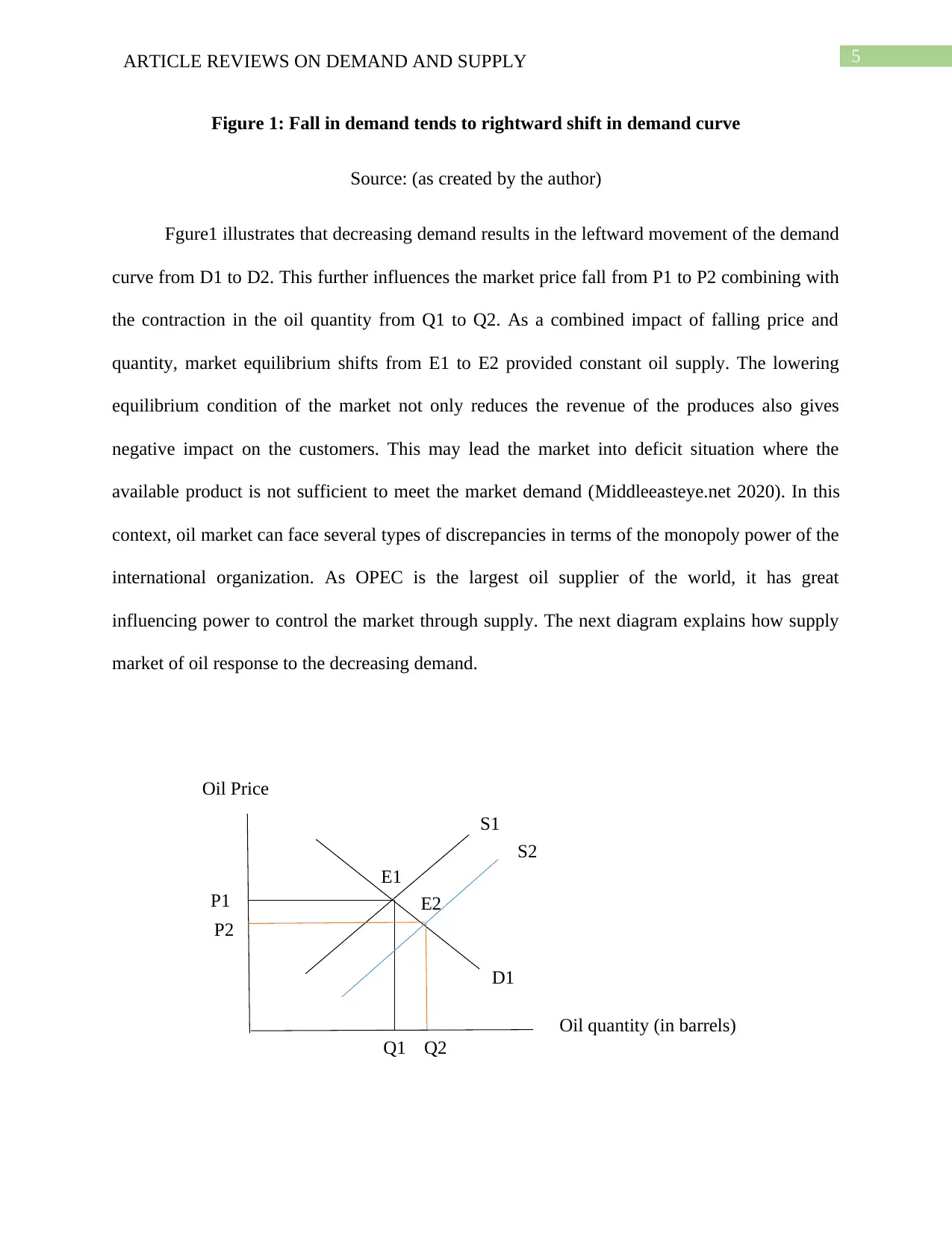
5ARTICLE REVIEWS ON DEMAND AND SUPPLY
S1
S2
D1
Oil quantity (in barrels)
Oil Price
Q1 Q2
P1
P2
E1
E2
Figure 1: Fall in demand tends to rightward shift in demand curve
Source: (as created by the author)
Fgure1 illustrates that decreasing demand results in the leftward movement of the demand
curve from D1 to D2. This further influences the market price fall from P1 to P2 combining with
the contraction in the oil quantity from Q1 to Q2. As a combined impact of falling price and
quantity, market equilibrium shifts from E1 to E2 provided constant oil supply. The lowering
equilibrium condition of the market not only reduces the revenue of the produces also gives
negative impact on the customers. This may lead the market into deficit situation where the
available product is not sufficient to meet the market demand (Middleeasteye.net 2020). In this
context, oil market can face several types of discrepancies in terms of the monopoly power of the
international organization. As OPEC is the largest oil supplier of the world, it has great
influencing power to control the market through supply. The next diagram explains how supply
market of oil response to the decreasing demand.
S1
S2
D1
Oil quantity (in barrels)
Oil Price
Q1 Q2
P1
P2
E1
E2
Figure 1: Fall in demand tends to rightward shift in demand curve
Source: (as created by the author)
Fgure1 illustrates that decreasing demand results in the leftward movement of the demand
curve from D1 to D2. This further influences the market price fall from P1 to P2 combining with
the contraction in the oil quantity from Q1 to Q2. As a combined impact of falling price and
quantity, market equilibrium shifts from E1 to E2 provided constant oil supply. The lowering
equilibrium condition of the market not only reduces the revenue of the produces also gives
negative impact on the customers. This may lead the market into deficit situation where the
available product is not sufficient to meet the market demand (Middleeasteye.net 2020). In this
context, oil market can face several types of discrepancies in terms of the monopoly power of the
international organization. As OPEC is the largest oil supplier of the world, it has great
influencing power to control the market through supply. The next diagram explains how supply
market of oil response to the decreasing demand.
⊘ This is a preview!⊘
Do you want full access?
Subscribe today to unlock all pages.

Trusted by 1+ million students worldwide
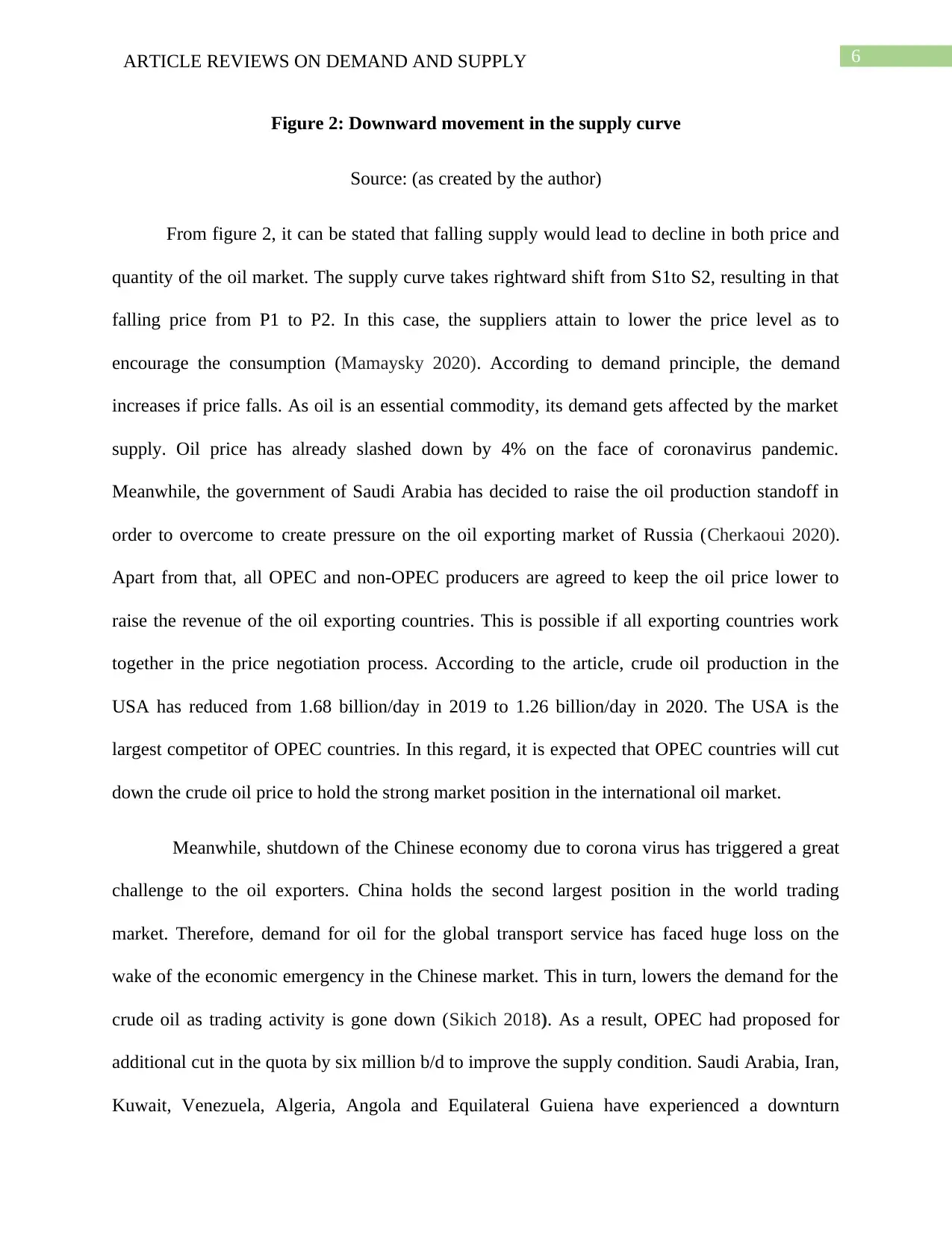
6ARTICLE REVIEWS ON DEMAND AND SUPPLY
Figure 2: Downward movement in the supply curve
Source: (as created by the author)
From figure 2, it can be stated that falling supply would lead to decline in both price and
quantity of the oil market. The supply curve takes rightward shift from S1to S2, resulting in that
falling price from P1 to P2. In this case, the suppliers attain to lower the price level as to
encourage the consumption (Mamaysky 2020). According to demand principle, the demand
increases if price falls. As oil is an essential commodity, its demand gets affected by the market
supply. Oil price has already slashed down by 4% on the face of coronavirus pandemic.
Meanwhile, the government of Saudi Arabia has decided to raise the oil production standoff in
order to overcome to create pressure on the oil exporting market of Russia (Cherkaoui 2020).
Apart from that, all OPEC and non-OPEC producers are agreed to keep the oil price lower to
raise the revenue of the oil exporting countries. This is possible if all exporting countries work
together in the price negotiation process. According to the article, crude oil production in the
USA has reduced from 1.68 billion/day in 2019 to 1.26 billion/day in 2020. The USA is the
largest competitor of OPEC countries. In this regard, it is expected that OPEC countries will cut
down the crude oil price to hold the strong market position in the international oil market.
Meanwhile, shutdown of the Chinese economy due to corona virus has triggered a great
challenge to the oil exporters. China holds the second largest position in the world trading
market. Therefore, demand for oil for the global transport service has faced huge loss on the
wake of the economic emergency in the Chinese market. This in turn, lowers the demand for the
crude oil as trading activity is gone down (Sikich 2018). As a result, OPEC had proposed for
additional cut in the quota by six million b/d to improve the supply condition. Saudi Arabia, Iran,
Kuwait, Venezuela, Algeria, Angola and Equilateral Guiena have experienced a downturn
Figure 2: Downward movement in the supply curve
Source: (as created by the author)
From figure 2, it can be stated that falling supply would lead to decline in both price and
quantity of the oil market. The supply curve takes rightward shift from S1to S2, resulting in that
falling price from P1 to P2. In this case, the suppliers attain to lower the price level as to
encourage the consumption (Mamaysky 2020). According to demand principle, the demand
increases if price falls. As oil is an essential commodity, its demand gets affected by the market
supply. Oil price has already slashed down by 4% on the face of coronavirus pandemic.
Meanwhile, the government of Saudi Arabia has decided to raise the oil production standoff in
order to overcome to create pressure on the oil exporting market of Russia (Cherkaoui 2020).
Apart from that, all OPEC and non-OPEC producers are agreed to keep the oil price lower to
raise the revenue of the oil exporting countries. This is possible if all exporting countries work
together in the price negotiation process. According to the article, crude oil production in the
USA has reduced from 1.68 billion/day in 2019 to 1.26 billion/day in 2020. The USA is the
largest competitor of OPEC countries. In this regard, it is expected that OPEC countries will cut
down the crude oil price to hold the strong market position in the international oil market.
Meanwhile, shutdown of the Chinese economy due to corona virus has triggered a great
challenge to the oil exporters. China holds the second largest position in the world trading
market. Therefore, demand for oil for the global transport service has faced huge loss on the
wake of the economic emergency in the Chinese market. This in turn, lowers the demand for the
crude oil as trading activity is gone down (Sikich 2018). As a result, OPEC had proposed for
additional cut in the quota by six million b/d to improve the supply condition. Saudi Arabia, Iran,
Kuwait, Venezuela, Algeria, Angola and Equilateral Guiena have experienced a downturn
Paraphrase This Document
Need a fresh take? Get an instant paraphrase of this document with our AI Paraphraser
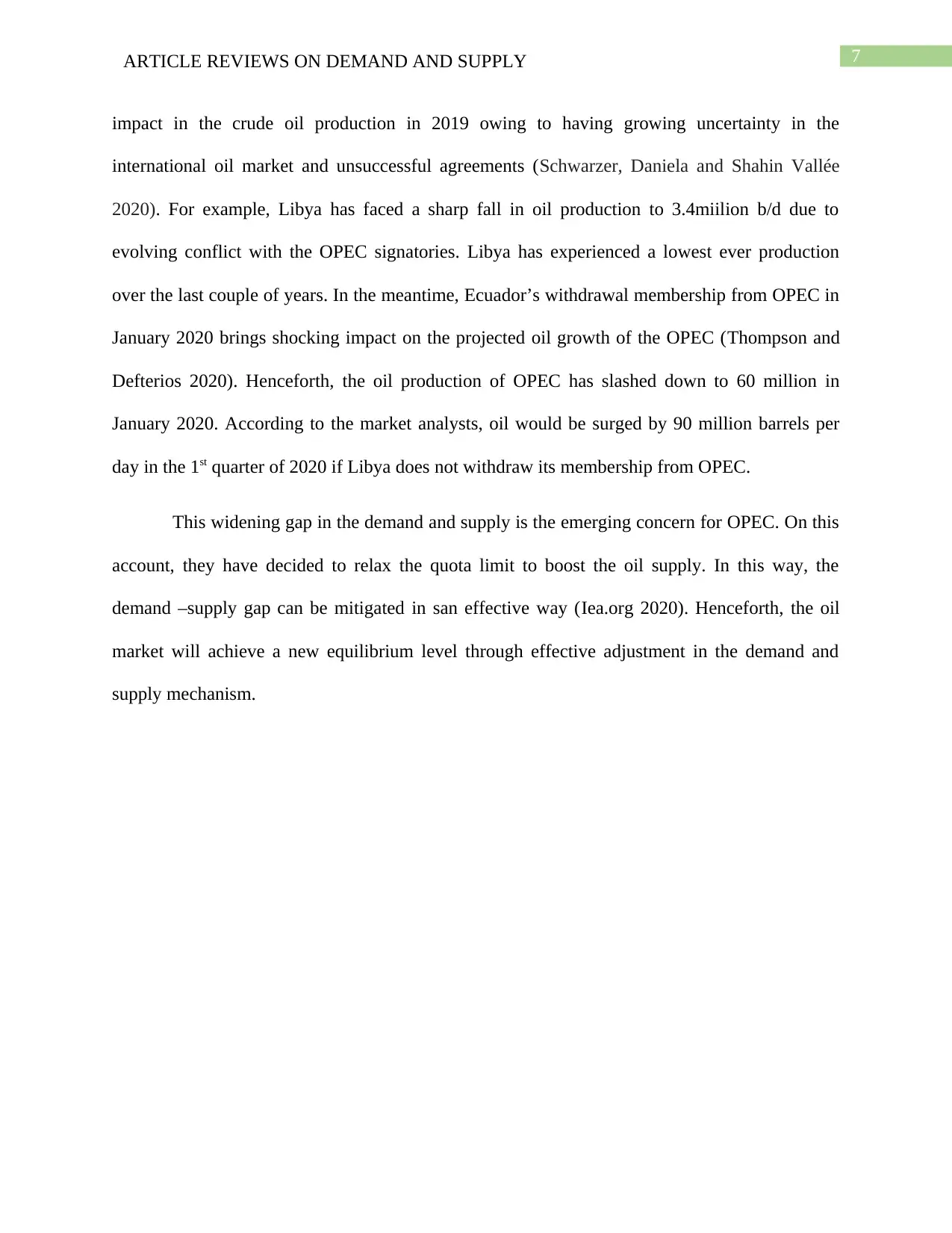
7ARTICLE REVIEWS ON DEMAND AND SUPPLY
impact in the crude oil production in 2019 owing to having growing uncertainty in the
international oil market and unsuccessful agreements (Schwarzer, Daniela and Shahin Vallée
2020). For example, Libya has faced a sharp fall in oil production to 3.4miilion b/d due to
evolving conflict with the OPEC signatories. Libya has experienced a lowest ever production
over the last couple of years. In the meantime, Ecuador’s withdrawal membership from OPEC in
January 2020 brings shocking impact on the projected oil growth of the OPEC (Thompson and
Defterios 2020). Henceforth, the oil production of OPEC has slashed down to 60 million in
January 2020. According to the market analysts, oil would be surged by 90 million barrels per
day in the 1st quarter of 2020 if Libya does not withdraw its membership from OPEC.
This widening gap in the demand and supply is the emerging concern for OPEC. On this
account, they have decided to relax the quota limit to boost the oil supply. In this way, the
demand –supply gap can be mitigated in san effective way (Iea.org 2020). Henceforth, the oil
market will achieve a new equilibrium level through effective adjustment in the demand and
supply mechanism.
impact in the crude oil production in 2019 owing to having growing uncertainty in the
international oil market and unsuccessful agreements (Schwarzer, Daniela and Shahin Vallée
2020). For example, Libya has faced a sharp fall in oil production to 3.4miilion b/d due to
evolving conflict with the OPEC signatories. Libya has experienced a lowest ever production
over the last couple of years. In the meantime, Ecuador’s withdrawal membership from OPEC in
January 2020 brings shocking impact on the projected oil growth of the OPEC (Thompson and
Defterios 2020). Henceforth, the oil production of OPEC has slashed down to 60 million in
January 2020. According to the market analysts, oil would be surged by 90 million barrels per
day in the 1st quarter of 2020 if Libya does not withdraw its membership from OPEC.
This widening gap in the demand and supply is the emerging concern for OPEC. On this
account, they have decided to relax the quota limit to boost the oil supply. In this way, the
demand –supply gap can be mitigated in san effective way (Iea.org 2020). Henceforth, the oil
market will achieve a new equilibrium level through effective adjustment in the demand and
supply mechanism.
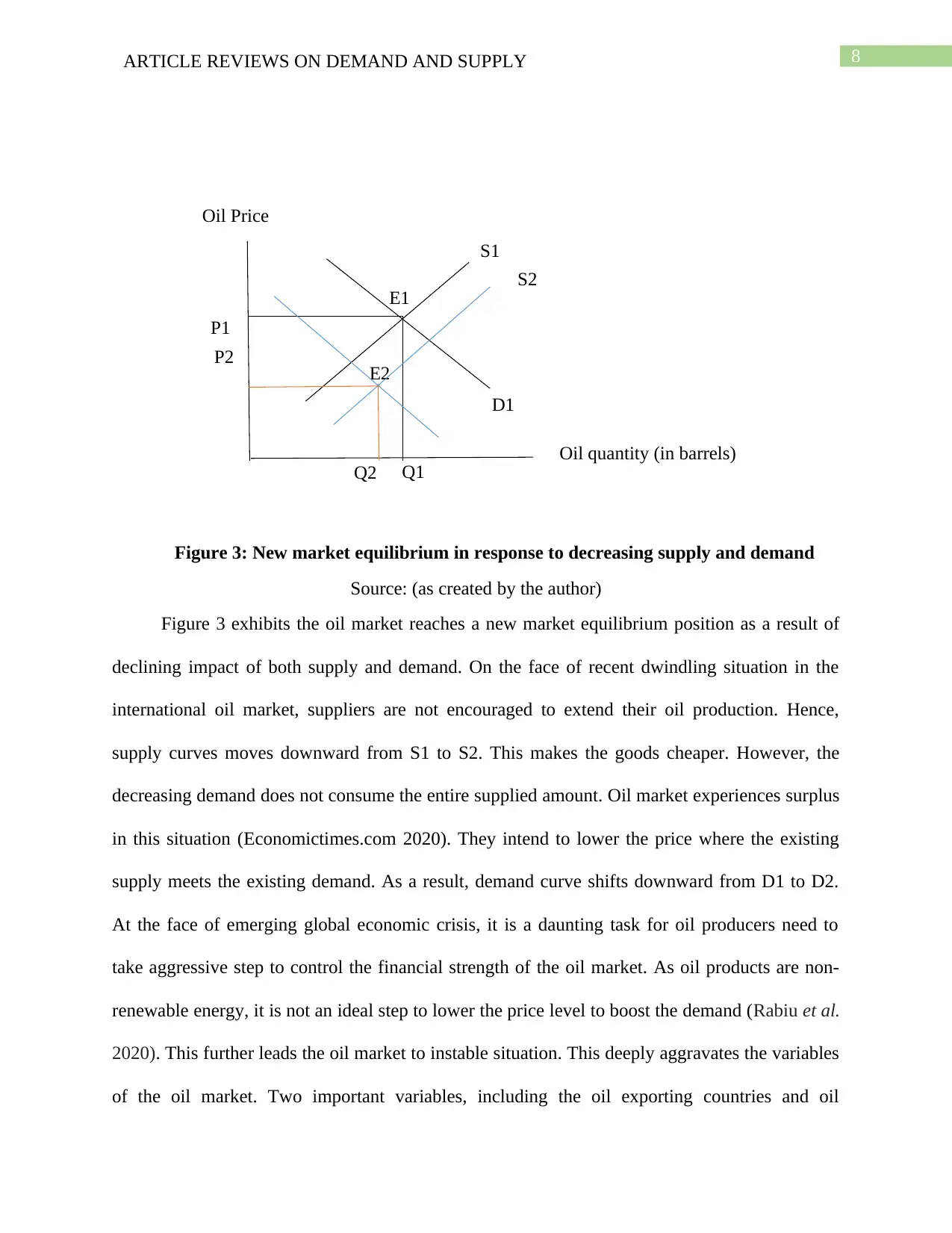
8ARTICLE REVIEWS ON DEMAND AND SUPPLY
S1
S2
D1
Oil quantity (in barrels)
Oil Price
Q1Q2
P1
P2
E1
E2
Figure 3: New market equilibrium in response to decreasing supply and demand
Source: (as created by the author)
Figure 3 exhibits the oil market reaches a new market equilibrium position as a result of
declining impact of both supply and demand. On the face of recent dwindling situation in the
international oil market, suppliers are not encouraged to extend their oil production. Hence,
supply curves moves downward from S1 to S2. This makes the goods cheaper. However, the
decreasing demand does not consume the entire supplied amount. Oil market experiences surplus
in this situation (Economictimes.com 2020). They intend to lower the price where the existing
supply meets the existing demand. As a result, demand curve shifts downward from D1 to D2.
At the face of emerging global economic crisis, it is a daunting task for oil producers need to
take aggressive step to control the financial strength of the oil market. As oil products are non-
renewable energy, it is not an ideal step to lower the price level to boost the demand (Rabiu et al.
2020). This further leads the oil market to instable situation. This deeply aggravates the variables
of the oil market. Two important variables, including the oil exporting countries and oil
S1
S2
D1
Oil quantity (in barrels)
Oil Price
Q1Q2
P1
P2
E1
E2
Figure 3: New market equilibrium in response to decreasing supply and demand
Source: (as created by the author)
Figure 3 exhibits the oil market reaches a new market equilibrium position as a result of
declining impact of both supply and demand. On the face of recent dwindling situation in the
international oil market, suppliers are not encouraged to extend their oil production. Hence,
supply curves moves downward from S1 to S2. This makes the goods cheaper. However, the
decreasing demand does not consume the entire supplied amount. Oil market experiences surplus
in this situation (Economictimes.com 2020). They intend to lower the price where the existing
supply meets the existing demand. As a result, demand curve shifts downward from D1 to D2.
At the face of emerging global economic crisis, it is a daunting task for oil producers need to
take aggressive step to control the financial strength of the oil market. As oil products are non-
renewable energy, it is not an ideal step to lower the price level to boost the demand (Rabiu et al.
2020). This further leads the oil market to instable situation. This deeply aggravates the variables
of the oil market. Two important variables, including the oil exporting countries and oil
⊘ This is a preview!⊘
Do you want full access?
Subscribe today to unlock all pages.

Trusted by 1+ million students worldwide
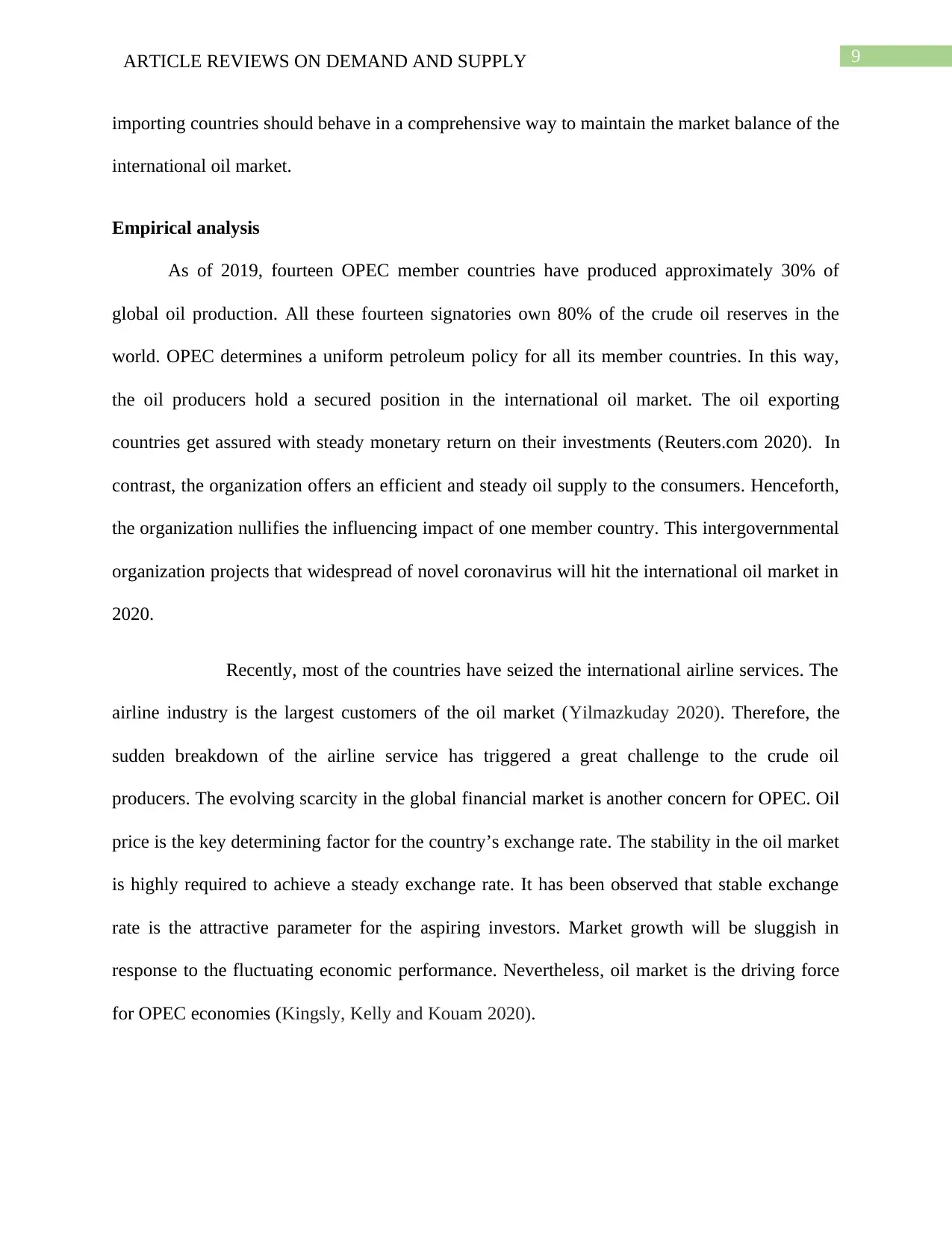
9ARTICLE REVIEWS ON DEMAND AND SUPPLY
importing countries should behave in a comprehensive way to maintain the market balance of the
international oil market.
Empirical analysis
As of 2019, fourteen OPEC member countries have produced approximately 30% of
global oil production. All these fourteen signatories own 80% of the crude oil reserves in the
world. OPEC determines a uniform petroleum policy for all its member countries. In this way,
the oil producers hold a secured position in the international oil market. The oil exporting
countries get assured with steady monetary return on their investments (Reuters.com 2020). In
contrast, the organization offers an efficient and steady oil supply to the consumers. Henceforth,
the organization nullifies the influencing impact of one member country. This intergovernmental
organization projects that widespread of novel coronavirus will hit the international oil market in
2020.
Recently, most of the countries have seized the international airline services. The
airline industry is the largest customers of the oil market (Yilmazkuday 2020). Therefore, the
sudden breakdown of the airline service has triggered a great challenge to the crude oil
producers. The evolving scarcity in the global financial market is another concern for OPEC. Oil
price is the key determining factor for the country’s exchange rate. The stability in the oil market
is highly required to achieve a steady exchange rate. It has been observed that stable exchange
rate is the attractive parameter for the aspiring investors. Market growth will be sluggish in
response to the fluctuating economic performance. Nevertheless, oil market is the driving force
for OPEC economies (Kingsly, Kelly and Kouam 2020).
importing countries should behave in a comprehensive way to maintain the market balance of the
international oil market.
Empirical analysis
As of 2019, fourteen OPEC member countries have produced approximately 30% of
global oil production. All these fourteen signatories own 80% of the crude oil reserves in the
world. OPEC determines a uniform petroleum policy for all its member countries. In this way,
the oil producers hold a secured position in the international oil market. The oil exporting
countries get assured with steady monetary return on their investments (Reuters.com 2020). In
contrast, the organization offers an efficient and steady oil supply to the consumers. Henceforth,
the organization nullifies the influencing impact of one member country. This intergovernmental
organization projects that widespread of novel coronavirus will hit the international oil market in
2020.
Recently, most of the countries have seized the international airline services. The
airline industry is the largest customers of the oil market (Yilmazkuday 2020). Therefore, the
sudden breakdown of the airline service has triggered a great challenge to the crude oil
producers. The evolving scarcity in the global financial market is another concern for OPEC. Oil
price is the key determining factor for the country’s exchange rate. The stability in the oil market
is highly required to achieve a steady exchange rate. It has been observed that stable exchange
rate is the attractive parameter for the aspiring investors. Market growth will be sluggish in
response to the fluctuating economic performance. Nevertheless, oil market is the driving force
for OPEC economies (Kingsly, Kelly and Kouam 2020).
Paraphrase This Document
Need a fresh take? Get an instant paraphrase of this document with our AI Paraphraser
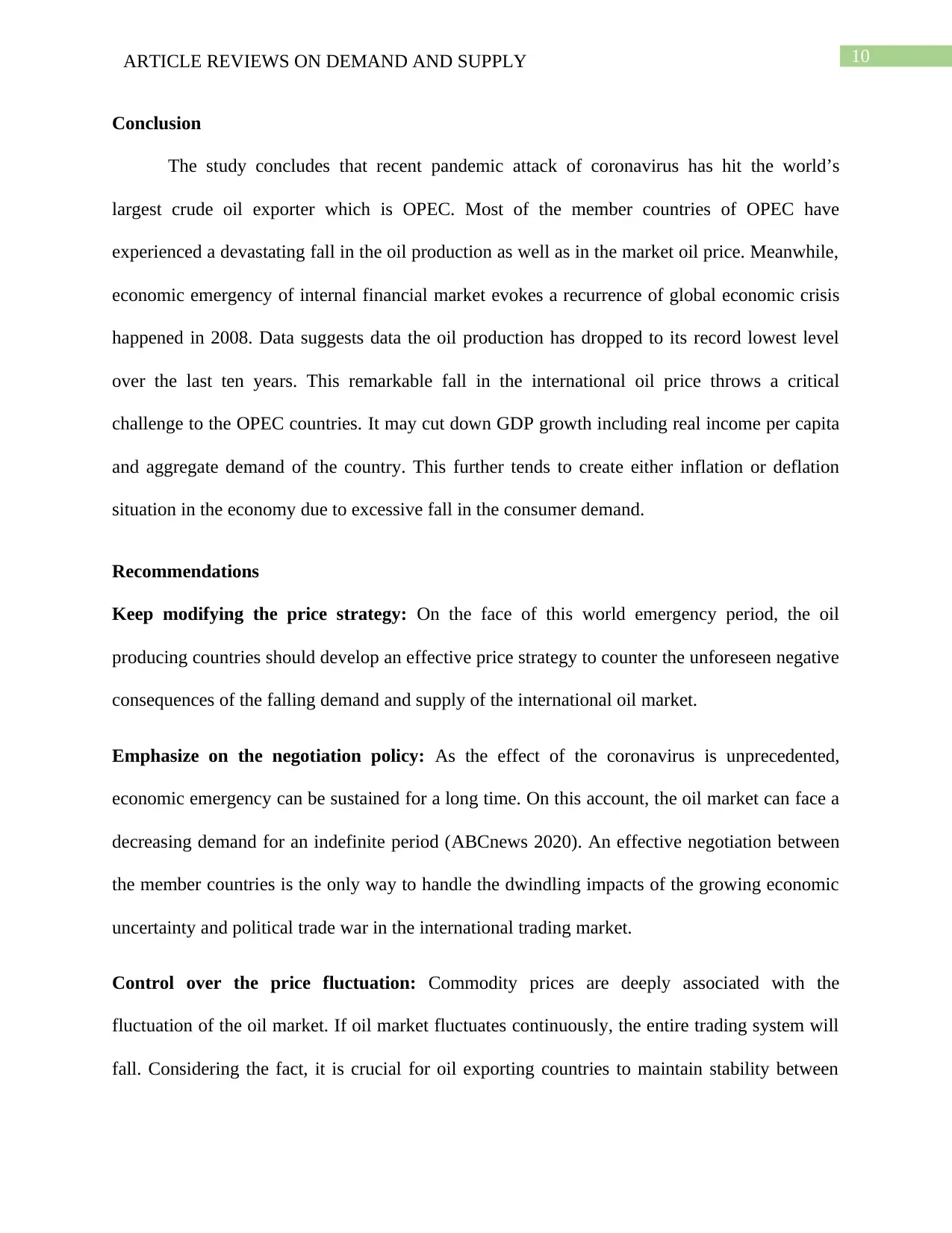
10ARTICLE REVIEWS ON DEMAND AND SUPPLY
Conclusion
The study concludes that recent pandemic attack of coronavirus has hit the world’s
largest crude oil exporter which is OPEC. Most of the member countries of OPEC have
experienced a devastating fall in the oil production as well as in the market oil price. Meanwhile,
economic emergency of internal financial market evokes a recurrence of global economic crisis
happened in 2008. Data suggests data the oil production has dropped to its record lowest level
over the last ten years. This remarkable fall in the international oil price throws a critical
challenge to the OPEC countries. It may cut down GDP growth including real income per capita
and aggregate demand of the country. This further tends to create either inflation or deflation
situation in the economy due to excessive fall in the consumer demand.
Recommendations
Keep modifying the price strategy: On the face of this world emergency period, the oil
producing countries should develop an effective price strategy to counter the unforeseen negative
consequences of the falling demand and supply of the international oil market.
Emphasize on the negotiation policy: As the effect of the coronavirus is unprecedented,
economic emergency can be sustained for a long time. On this account, the oil market can face a
decreasing demand for an indefinite period (ABCnews 2020). An effective negotiation between
the member countries is the only way to handle the dwindling impacts of the growing economic
uncertainty and political trade war in the international trading market.
Control over the price fluctuation: Commodity prices are deeply associated with the
fluctuation of the oil market. If oil market fluctuates continuously, the entire trading system will
fall. Considering the fact, it is crucial for oil exporting countries to maintain stability between
Conclusion
The study concludes that recent pandemic attack of coronavirus has hit the world’s
largest crude oil exporter which is OPEC. Most of the member countries of OPEC have
experienced a devastating fall in the oil production as well as in the market oil price. Meanwhile,
economic emergency of internal financial market evokes a recurrence of global economic crisis
happened in 2008. Data suggests data the oil production has dropped to its record lowest level
over the last ten years. This remarkable fall in the international oil price throws a critical
challenge to the OPEC countries. It may cut down GDP growth including real income per capita
and aggregate demand of the country. This further tends to create either inflation or deflation
situation in the economy due to excessive fall in the consumer demand.
Recommendations
Keep modifying the price strategy: On the face of this world emergency period, the oil
producing countries should develop an effective price strategy to counter the unforeseen negative
consequences of the falling demand and supply of the international oil market.
Emphasize on the negotiation policy: As the effect of the coronavirus is unprecedented,
economic emergency can be sustained for a long time. On this account, the oil market can face a
decreasing demand for an indefinite period (ABCnews 2020). An effective negotiation between
the member countries is the only way to handle the dwindling impacts of the growing economic
uncertainty and political trade war in the international trading market.
Control over the price fluctuation: Commodity prices are deeply associated with the
fluctuation of the oil market. If oil market fluctuates continuously, the entire trading system will
fall. Considering the fact, it is crucial for oil exporting countries to maintain stability between
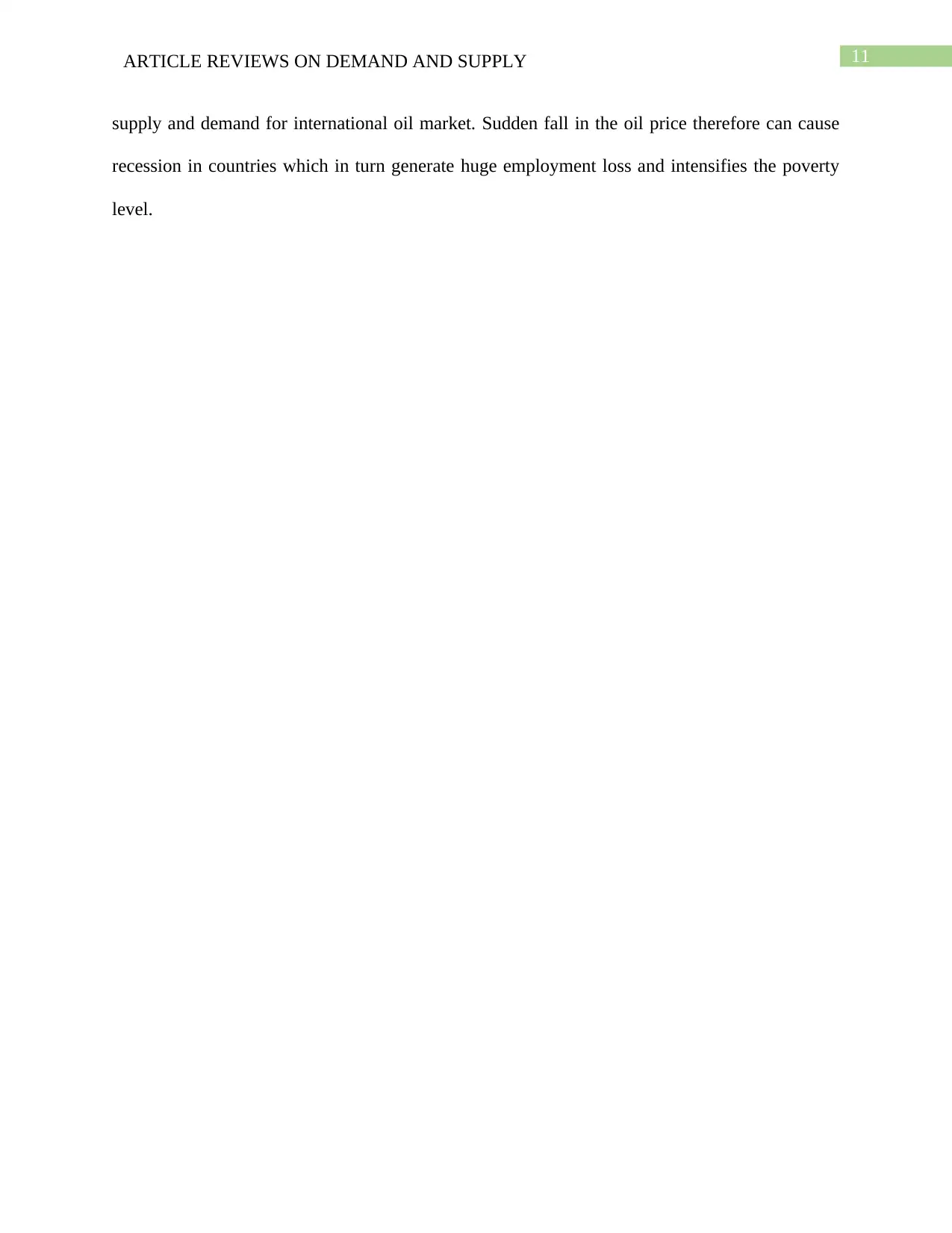
11ARTICLE REVIEWS ON DEMAND AND SUPPLY
supply and demand for international oil market. Sudden fall in the oil price therefore can cause
recession in countries which in turn generate huge employment loss and intensifies the poverty
level.
supply and demand for international oil market. Sudden fall in the oil price therefore can cause
recession in countries which in turn generate huge employment loss and intensifies the poverty
level.
⊘ This is a preview!⊘
Do you want full access?
Subscribe today to unlock all pages.

Trusted by 1+ million students worldwide
1 out of 19
Related Documents
Your All-in-One AI-Powered Toolkit for Academic Success.
+13062052269
info@desklib.com
Available 24*7 on WhatsApp / Email
![[object Object]](/_next/static/media/star-bottom.7253800d.svg)
Unlock your academic potential
Copyright © 2020–2025 A2Z Services. All Rights Reserved. Developed and managed by ZUCOL.





